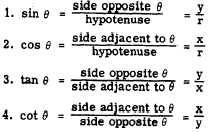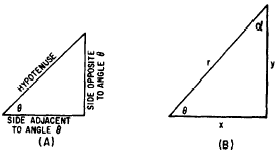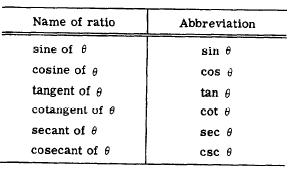|
TRIGONOMETRIC RATIOS
The relationships between the angles and the sides
of a right triangle are expressed in terms of
TRIGONOMETRIC RATIOS. For example, in figure
19-7, the sides of the triangle are named in
accordance with their relationship to angle q.
In trigonometry, angles are usually named by means
of Greek letters. The Greek name of the
symbol q is theta.
The six trigonometric ratios for the angle q
are listed in table 19-1.
The-ratios are defined as follows:


Figure 19-1.-Relationship of sides and angles in
a right triangle. (A) Names of the sides; (B)
symbols used to designate the sides.
Table 19-1.-Trigonometric ratios.


The other acute angle in figure 19-7 (B) is labeled
a (Greek alpha). The side opposite a
is x and the side adjacent to a
is y. Therefore the six ratios for a
are as follows:

Suppose that the sides of triangle (B) in figure 19-7 are as follows: x = 3,
y.= 4, r = 5. Then each of the ratios for
angles q and a may be
expressed as a common fraction or as a decimal.
For example,

Decimal values have been computed for ratios
of angles between 0 and 90,
and values for angles above 90" can be
expressed in terms of these same values by
means of conversion formulas. Appendix II of
this training course gives the sine, cosine,
and tangent of angles from 0
to 90. The secant, cosecant, and cotangent
are calculated, when needed, by using their
relationships to the three principal ratios. These
relationships are as follows:

|







